 Accordion
Reed Production
Photographs by Eugenio Gilbertini©. Text supplied by VOCI ARMONICHE. |
|
View
the production process of VOCI
ARMONICHE
|
| The
purpose and aim of this initiative is to contribute in the spread of knowledge
to accordion lovers and people interested in this wonderful instrument.
Behind this intention is the belief, that the more profound the knowledge
of the product, the more this helps clients to choose with care the instrument
best suited to their needs, increasing satisfaction to the purchaser and
performer. The basic materials of the reed are a plate, two tongues, two rivets, and into these materials must be added a lot of work and a wealth of skilled experience. This kind of work is not easy. There are reeds which sound beautiful and improve, the longer they are played. Other reeds sound only satisfactory, and there are also reeds which produce an unsatisfactory sound. This visit using photographic images from an Italian factory, which has produced reeds since 1935, is intended to show the production steps in the manufacture of this most important component of the accordion. |
 |
The
Profile of the Reed Tongue: The Harmonic steel precision strip (which must have special features referring to hardness and ductility) is the raw material for the reed tongues. To have a steel tongue produce a note, it is necessary to shape the profile of the tongue by removing material. To carry out this operation, a carefully designed profile must be set up on a metal shape. This shape will direct the grindstone, so it will remove the steel from the tongue to achieve the required tongue shape. This photo shows the metal shape on which the tongue profile is ground. |
|
The
Research for a Better Profile:
Each note has its own profile; there are over 400 different notes as they have many scales, types and sizes of reeds in production. To each single reed belongs its best profile in terms of hardness and shape, to guarantee the best quality sound output. The photo shows the filing by hand of the shape, working on a tolerance of hundredth millimetre. To be considerated as WELL DONE, on bending the tongue, it has to show a round homogeneous and slim curve. |
 |
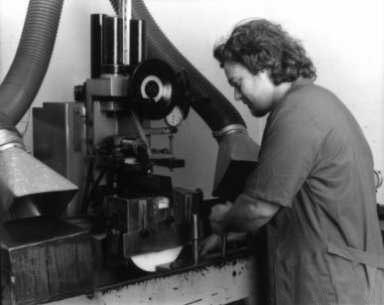 |
The
Grinder: This is a most important production phase. Adequate grindstones together with a special technique are necessary to avoid steel overheating and to retain the sound quality of the metal. The steel is ground in plates (approx. 16 tongues) or in small strips / band (two tongues each for A MANO - hand made |
|
Cutting
of Reed Plates:
With special moulds, the reed plates are cut from an aluminium sheet (which can be a hard or soft aluminium type) complete with holes for the tongues and rivets. While reeds plates in soft aluminium are ready to be assembled, reeds plates in Duraluminium for TIPO A MANO (hand type) or A MANO (hand made) reeds must also be filed inside the holes to guarantee maximum precision. |
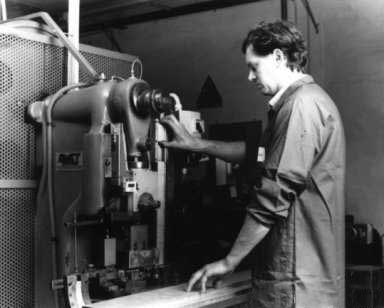 |
 |
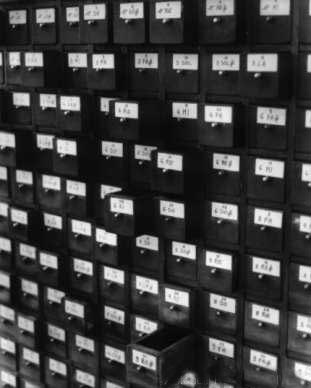 |
| Cutting
of Reeds Tongues: The ground reed plates and the ground small strips/bands are cut with special moulds made of extremely hard steel. These moulds need constant upkeep and control to assure high quality cutting of the reeds tongues, with very exact tolerances (hundred mm) being constantly checked. |
Warehouse
of Reed Tongues:
The photo shows the wooden drawers where the reed tongues, after they have been cut, are kept to avoid any oxidation / rust. Each drawer corresponds to a note and reed type. |
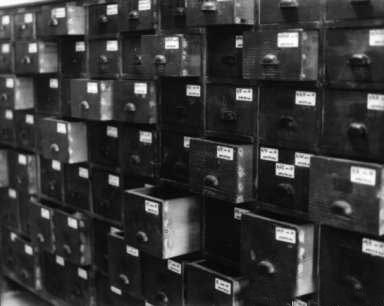 |
Warehouse
of Reeds Plates: This photo shows drawers with reeds plates that have been cut and are ready for assembling. |
| Assembling
Reeds in Sets: The assemblers follow the schedules that have been filled in as per the customer's requests, and reed sets are selected according to the different accordion models requested. The individual reeds are next selected to be assembled into sets. This selection must pick the correct reed design and quality so as to produce a consistent set. |
 |
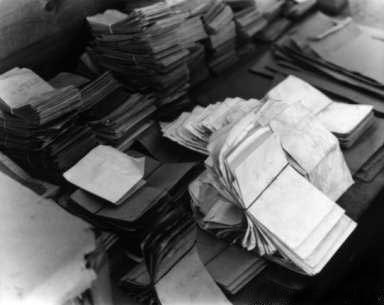 |
Paper
Bags/Envelopes: Following the notes schedules, is the identification of the envelopes, which will include the partly finished materials: reed plates, reeds tongues and rivets. Normally, each envelope contains different quantities referring to one type of reed. A group of envelopes corresponds to an accordion set. |
|
Site constructed and hosted by: Accordions
Worldwide at www.accordions.com.
© Copyright 2003 Accordions Worldwide. All rights reserved |